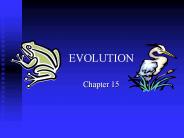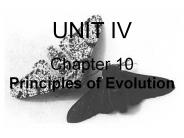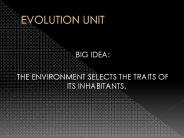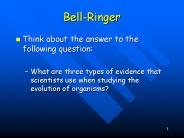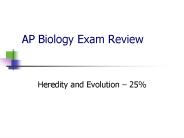Vestigial Organs In Different Organisms PowerPoint PPT Presentations
All Time
Recommended
evidences for organic evolution
| PowerPoint PPT presentation | free to download
Organic Evolution Chapter 6
| PowerPoint PPT presentation | free to download
Title: Descent with Modification Author: Nancy Wheat Last modified by: Nancy Created Date: 1/29/2006 5:20:29 PM Document presentation format: On-screen Show (4:3)
| PowerPoint PPT presentation | free to view
reveals phylogeny ('tree of life through time') Organic evolution: conclusions ... Phylogeny. relationships between organisms can be determined using. genetics ...
| PowerPoint PPT presentation | free to view
How do organisms adapt and change over time? Natural Selection Must Haves: Overproduction of off-spring Inherited variation or differences Struggle to survive ...
| PowerPoint PPT presentation | free to view
Changes in Organisms Over Time 1 Age of Earth Natural Selection What if the environment changes? The organisms that are most suited will survive, the others will die.
| PowerPoint PPT presentation | free to view
Evidence for Evolution Descent with Modification Over time, natural selection produces different organisms Different structures Different niches Different habitats ...
| PowerPoint PPT presentation | free to view
Analogous and Vestigial Structures Write in complete sentences! Don t talk during the Catalyst! Catalyst Cougars eat Bucaneers, which have decreased in population ...
| PowerPoint PPT presentation | free to view
There is a Great Diversity of Organisms
| PowerPoint PPT presentation | free to download
PowerPoint Presentation
| PowerPoint PPT presentation | free to download
GROUP 1 GROUP 2 GROUP 3 GROUP 4 GROUP 5 100 100 100 100 100 200 200 200 200 200 300 300 300 300 300 400 400 400 400 400 500 500 500 500 500 Organisms that obtain ...
| PowerPoint PPT presentation | free to view
Does not prove evolution, but gives evidence that there was a ... All vertebrates share a common embryology but become progressively different as they develop ...
| PowerPoint PPT presentation | free to view
Last day how to classify organisms
| PowerPoint PPT presentation | free to view
Evidence of Evolution. The Fossil Record ... Evidence for Evolution. Vestigial organs-organs that serve no useful function in an organism ...
| PowerPoint PPT presentation | free to download
AP Lab #7 Genetics of Organisms Virtual Fly Lab Instructions Instructions: 1. Find the Fly Lab Manual in your box of materials use the access code found in the manual ...
| PowerPoint PPT presentation | free to view
chapter 22 Descent With Modification: A Darwinian View of Life Darwin Lamarck Lyell Linnaeus Hooke Vestigial Organs Homologous structures Analogous Structures
| PowerPoint PPT presentation | free to download
Welcome to Jeopardy! Today s Topic: Evolution With Your Favorite Host: Ms. Ings Ear muscles are an example of A. Homologous Parts B. Vestigial Organs C ...
| PowerPoint PPT presentation | free to view
http://www.pbs.org/wgbh/evolution/library/03/4/l_034_05.html 2. ... but different in function Examples: The arm bones of various organisms 4.
| PowerPoint PPT presentation | free to view
... during an organism's lifetime could be inherited by that organism's offspring. Georges Cuvier (1769-1832) Created Paleontology (The study of fossils) ...
| PowerPoint PPT presentation | free to download
Evolution Evidence of Evolution SBI 4U evolution Outline Fossil Evidence Comparative Anatomy Homologous Structures Analogous Structures Vestigial Organs and ...
| PowerPoint PPT presentation | free to download
Think: 'human arm, bat wing' vestigial organs. organs or body parts that have reduced and lost ... evolutionary tree. Think: 'diagram of how life changed ...
| PowerPoint PPT presentation | free to view
Evolution Changes in types of organisms over a period of time Fossils A fossil is some remnant of an organism that proves its existence Imprints of bacteria, leaves ...
| PowerPoint PPT presentation | free to download
Convergent Evolution when unrelated or distantly related organisms possess ... Divergent Evolution each group spreads out and occupies as many different ...
| PowerPoint PPT presentation | free to view
The different sizes, shapes and habitats of organisms is ... Coypu. Capybara. Coypu and Capybara. Turtle. Alligator. Bird. Mammal. Ancient lobe-finned fish ...
| PowerPoint PPT presentation | free to view
Human Digestion -Ch. 21.1 Section Objectives: Interpret the different functions of the digestive system organs. Outline the pathway food follows through the digestive ...
| PowerPoint PPT presentation | free to view
Human Digestion -Ch. 21.1 Section Objectives: Interpret the different functions of the digestive system organs. Outline the pathway food follows through the digestive ...
| PowerPoint PPT presentation | free to view
Stated that Changes Are Adaptations To Environment acquired in an organism's lifetime ... A Revolutionary Hypothesis About The Way Life Changes Over Time ...
| PowerPoint PPT presentation | free to view
Ch 15 Evolution Question and Answer True/False Indicate whether the statement is true or false 1. A vestigial structure in one organism can be defined as a reduced ...
| PowerPoint PPT presentation | free to view
Proposed that organisms changed over time due to use and disuse of certain organs/parts. ... When individuals at one end of the population curve have higher ...
| PowerPoint PPT presentation | free to view
... animals Fish Mammal Bird Human Vestigial Structures Vestigial structures something that no longer does what it was evolved for On humans: ...
| PowerPoint PPT presentation | free to download
Unit 5 Evolution Ch. 15 Darwin s Theory of Evolution The Puzzle of Life s Diversity Evolution - modern organisms have descended from ancient organisms (change ...
| PowerPoint PPT presentation | free to view
Chapter 22 Notes: Introduction to Evolution Our planet is home to a huge variety of organisms (Scientists estimate 5-20 million species of organisms alive today!)
| PowerPoint PPT presentation | free to view
What is evolution? A gradual change in the genes of a population of organisms over time
| PowerPoint PPT presentation | free to download
Evidence of Evolution and Natural Selection Evolution The development of new types of organisms from preexisting types of organisms Evidence of Evolution Short scale ...
| PowerPoint PPT presentation | free to view
Chapter 10 Principles of Evolution ... What is evolution? a. the increased reproductive success ... Proposed changes in environment caused an organism behavior ...
| PowerPoint PPT presentation | free to download
Life Science 2nd Semester Exam Review Basic Concepts Structure of Ecosystems/Levels of Organization Organism individual living (biotic) thing Population group ...
| PowerPoint PPT presentation | free to view
Evolution Coevolution Transitional Species The Whale: How it has evolved Adaptations * Layers, distribution of fossils in layers-layers close together (organisms look ...
| PowerPoint PPT presentation | free to view
Scientific Evidence for Evolution Biochemical Comparisons On top of that Proteins in all organisms are composed of the same set of 20 amino acids.
| PowerPoint PPT presentation | free to view
Evolution Evolution: The change over time of the genetic composition of populations Natural selection: Populations of organisms can change over the generations ...
| PowerPoint PPT presentation | free to view
BIG IDEA: THE ENVIRONMENT SELECTS THE TRAITS OF ITS INHABITANTS. Lamarck s Theory Darwin s Theory The environment changes Which creates a need for organisms to ...
| PowerPoint PPT presentation | free to download
Evolution Evolution- is the process by which populations accumulate inherited changes over time Adaptation- a characteristic that helps and organism and in its ...
| PowerPoint PPT presentation | free to download
Bell-Ringer Think about the answer to the following question: What are three types of evidence that scientists use when studying the evolution of organisms?
| PowerPoint PPT presentation | free to download
... The Evidence Evolution also supported by the study of Embryology Embryology is the study of developing ... and ear muscles are called Vestigial Structures ...
| PowerPoint PPT presentation | free to download
Lesson 6.1 Objectives How scientists use fossils to learn about the history of life How organisms evolved more complex forms over time About mass extinctions
| PowerPoint PPT presentation | free to view
Evolution Notes Or, a scientific explanation for the diversity of life on our planet. Organisms have characteristics that help them survive well in their environment.
| PowerPoint PPT presentation | free to download
... * heterotrophs eat other organisms for food Homeostasis * maintenance or regulation ... by density-independent factors like ... create human proteins used to ...
| PowerPoint PPT presentation | free to download
Key Points. Heritable characteristics increase or decrease an organisms chance of survival. Evolution is the change of the genetic makeup of a population over time
| PowerPoint PPT presentation | free to download
Chap. 15 : Darwin s Theory of Evolution Fossils - traces of dead organisms, collect in sediments (dust, mud, etc) to form sedimentary rock.
| PowerPoint PPT presentation | free to download
Unit 5 Evolution Evidence of Evolution Evidence 1 Fossil: impression of dead organism made on a surface ... Coevolution Patterns of Evolution Convergent Evolution: ...
| PowerPoint PPT presentation | free to download
Evolution Part 1 The Evidence Evolution Outline I. What is evolution? II. Evidence of Evolution A. Evidence from the past (Fossils) B. Evidence from living organisms ...
| PowerPoint PPT presentation | free to download
Descent with Modification: A Darwinian View of Life Chapter 22 Historic Context Plato and Aristotle believed that organisms were perfectly formed and adapted to the ...
| PowerPoint PPT presentation | free to view
Natural Selection True or False Evolution is a theory about the origin of life. Important Vocabulary 1. Species: A group of organisms whose individuals can breed ...
| PowerPoint PPT presentation | free to download
4N can breed with 4N 8N offspring (polyploid) In one generation, ... able to synthesize simple organic compounds with flash of electricity ( lightning ); ...
| PowerPoint PPT presentation | free to download
Q: If a portion of a deer population is cut off from its parent population by a ... A: Different species of finch with different beak size and shapes, adapted to ...
| PowerPoint PPT presentation | free to view
A change in species of organisms over time. A process by which modern organisms have descended from ancient organisms. ... 2. Comparative Embryology ...
| PowerPoint PPT presentation | free to view
Open the Purple Box at your table. Pour out the contents onto your table. Organize all items in a way that make sense to everyone at the table. In your ISN, Explain ...
| PowerPoint PPT presentation | free to download














